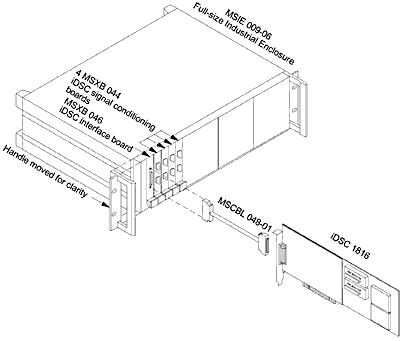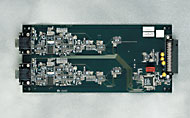
MSSC-8: Sensor Signal-Conditioning Module for the iDSC 1816
|
The 8-channel sensor signal-conditioning module, the MSSC-8, complements the 8-channel iDSC 1816 board to provide a continuous path in a single package: starting with raw measurements at the sensor and ending with conditioned anti-aliased data logged to disk on a PC.
An SCS-08 package consists of an industrial enclosure and one MSSC-8 signal-conditioning module. A single enclosure is sufficient for 8, 16, 24, or 32 channels, so SCS packages are available in each of those options. The SCS-32 package can be a part of an even larger system, for higher channel counts.
Each 8-channel MSSC-8 module contains four 2-channel MSXB 044 boards. The MSXB 044 board provides direct connection to sensors, and offers many signal-conditioning services in a single convenient, powerful package. These include
- current sensor excitation: 4 mA at up to 28 Volts
- voltage sensor excitation: 1, 2, 5, and 10 Volts at up to 70 mA
- quarter-, half-, and full-bridge resistor networks
- 120 and 350 ohm resistors as standard options
- any value resistor networks, sensor by sensor
- 10 full-scale options: 10 mV, 20 mV, 50 mV, 100 mV, 200 mV, 500 mV, and 1, 2, 5, and 10 Volts
- available offset ranges from between +/-0.5V to +/-5V, depending on the input option range used
Input Range Offset Range +/-10mV +/-0.5V +/-20mV +/-1V +/-50mV +/-2.5V +/-100mV +/-0.5V +/-200mV +/-1V +/-500mV +/-2.5V +/-1V +/-1V +/-2V +/-1V +/-5V +/-5V +/-10V +/-5V
- programmable gain with auto-calibration
- programmable AC/DC coupling for ICP sensors
A single 19-inch industrial enclosure can hold up to four MSSC-8 signal-conditioning modules for a total of 32 channels. This SCS-32 package, shown at right, can be a part of an even larger system, for higher channel counts. The line drawing below shows a single MSSC-8 module, 8 channels, in an SCS-08 package.

Signal Conditioning by Channel Count Each package consists of an enclosure and 1, 2, 3, or 4 MSSC-8 modules, for a total of 8, 16, 24, or 32 channels. |
This SCS-08 package consists of an MSIE 009-06 enclosure and a single 8-channel MSSC-8 module. The enclosure conceals most of the module, except for the ends of five boards. The SCS-08 package requires an MSCBL 048-01 cable to send conditioned signals to an iDSC 1816 anti-aliasing data acquisition board in a PC. It also requires another cable, not shown here, to carry power from the PC.
An MSCBL 048 cable connects the MSSC-8 sensor signal-conditioning module to an 8-channel iDSC 1816 data acquisition board that has built-in anti-aliasing filters. This combination scales up in two dimensions. First, a single PC may contain up to four iDSC 1816 boards -- each connected to an MSSC-8 -- for a total of 32 channels of conditioned anti-aliased data acquired at the maximum rate of 153.6k samples per second per channel.¹ Second, DAPcell network software, with at-the-server disk logging, supports multiple instances of these 32-channel modules controlled from a single DAPcell client.
The MSSC-8 brings with it the potential for hundreds of channels of simultaneously-sampled, conditioned, anti-aliased data logged to disk at up to 153.6k samples per second per channel.
Overview of System Components
Each MSXB 044 board conditions signals for two input channels. Four boards and an MSXB 046 interface board plug into an MSXB 047 backplane in a 5-slot 3U card cage provided by Microstar Laboratories. These components make up the hardware for a single 8-channel MSSC-8 signal-conditioning module. An MSCBL 048 cable runs from the MSXB 046 interface board to an 8-channel iDSC 1816 board occupying a PCI slot in a PC.
The MSCBL 048 cable carries signals to the PC. Another cable, not shown, carries power from it. The MSXB 046 converts 12-volt power from the PC to six voltage levels required for signal conditioning: +/-5 volts, +12 volts, +/-15 volts, and +30 volts. The MSXB 047 backplane distributes power at these different levels to the MSXB 044 boards plugged into the backplane, and it carries conditioned signals back from them on their way through the MSXB 046 interface board and the MSCBL 048 on to the iDSC 1816 in the PC.
A single PC can support up to fourteen iDSC 1816 boards. At these high channel counts, signal-conditioning power requirements likely will exceed 12-volt power normally available from the PC. In any case where this may happen, Microstar Laboratories can make special arrangements to boost the power provided by the PC.
Commercially available off-the-shelf PCs and associated disk controllers and drives have enough electrical power and enough computing power to form a balanced total system with four iDSC 1816 boards and four MSSC-8 sensor signal-conditioning modules. A total system like this can continuously log to disk all 32 channels of conditioned anti-aliased data at the full data acquisition rate of 153.6k samples per second -- an overall rate of just under 5 million samples per second.
An MSXB 045 board in each of two or more networked PCs, that each contain one or more iDSC 1816 boards, allows the whole networked system to work as a single synchronized system with possibly hundreds of conditioned channels.
Connector
The MSXB 044 board employs the widely available 15-pin sub-D (VGA) connector for each of its two channels. How the user wires the sensor to this connector determines the signal-conditioning services provided by the MSXB 044 board.
One pair of wires carries the signal, one pair the excitation voltage or current, and a third pair the feedback of the excitation voltage at the sensor.
Other pins determine the choice of quarter-, half-, or full-bridge resistor network, and allow the installation, within the connector, of specific resistors for customized networks for different sensors. So wiring the sensor-side of the connector in a specific way customizes the behavior of the MSXB 044 for that sensor.
One sensor after another can connect to the same channel of the MSXB 044, and each sensor can receive precisely the services it requires without any further attention.
A single 19-inch industrial enclosure can hold three more MSSC-8 signal-conditioning modules, as well as the one shown in the line drawing here, for a total of 32 channels -- as a total system on its own, or as a part of an even larger system.
If you want to download or print this information, you may want to take a look at the 362kB PDF file. You may be able to right-click on the link and save the file, if you would rather read it off-line.
¹ A single PC may contain more than four iDSC 1816 boards, but then may not log to disk at the full data acquisition rate. Four MSSC-8 modules exactly fit in a single full-size industrial enclosure.

